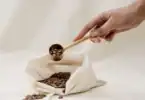Salt is salt … right? Well, not quite. The difference is in the details – so I often see questions about “this type of salt vs. that type of salt”. Can one be used like another? Sometimes the substitution are simple and sometimes, not so much. So in this article I thought I’d answer some questions related to Pickling Salt Vs. Himalayan Salt.
Pickling salt is formulated for pickling and canning. It is made from very pure granulated salt, and doesn’t contain additives or anti-caking agents. Himalayan salt is a pink rock salt that is known for its minerals, which includes iron, magnesium, and calcium, and is often used as a finishing salt.
- Pickling Salt – Pickling salt is a type of sodium chloride typically used for pickling food. The salt used has a low mineral content and fine grain size, which allows it to dissolve quickly into pickling liquid and prevents clumping. It’s ideal for preserving vegetables, eggs, or other ingredients.
- Himalayan Salt – Himalayan salt is a type of rock salt mined from the foothills of the Himalayas. It contains over 84 trace minerals, giving it a pink hue and a unique flavor, can come in a variety of grain sizes, making it ideal for seasoning foods and rubs.

Can You Use Himalayan Salt For Pickling?
Most cooking experts don’t recommend using Himalayan salt for pickling since the minerals that give it its signature pink color can affect the flavor of the food you are pickling.
That being said, some DIY cooks have tried pickling with Himalayan salt with good results, claiming that the minerals can actually add to the flavor. These same DIY cooks generally recommend learning how to pickle and can foods with traditional pickling salt first, and then start experimenting.
Aside from possibly not giving the flavor results you’re looking for, there are a few other downsides to using Himalayan salt in place of pickling salt, namely the higher price of Himalayan salt as well as possibly having to grind it first to speed up the process of dissolving in your pickling liquid.
Will Himalayan Salt Affect the Color of Pickled Products?
Because Himalayan salt has a natural pink color, it may leave a pink or reddish hue to pickled products when used in the pickling process. This is unlikely to be very noticeable unless you have lighter-colored vegetables, such as very thinly sliced cucumbers, radishes, or onions.
Himalayan salt usually does not contain anti-caking additives, so the salt should not cloud the pickling liquid. This issue, while not a health problem, is commonly thought to be unsightly for pretty pickles. Himalayan salt does have a unique flavor that may be desirable in certain pickled products, and it is also believed to have some health benefits due to its mineral content.
To learn more about the minerals in Himalayan salt, see our article: Minerals In Himalayan Salt: Let’s See What’s In There.
Is Himalayan Salt More Expensive than Pickling Salt?
Because it is mined from a specific location and has a unique mineral content, Himalayan salt is generally more expensive than regular pickling salt, which is made from salt that is produced via vacuum extraction.
The price difference between Himalayan salt and pickling salt can vary depending on the brand and the specific product. Himalayan salt is typically sold in larger crystals or in decorative salt mills (which of course increase the package price), while pickling salt is usually sold in bulk bags or boxes.
There’s also the bias of purchasing something considered exotic that will affect the price. If you want to experiment with pickling or canning foods with Himalayan salt, it’s a good idea to have a firm grasp on how to properly do it so that you can minimize waste and money loss.
Does Himalayan Salt Have Any Special Health Benefits for Pickling?
Minerals in Himalayan salt are believed to have health benefits however, it is important to note that there is currently limited scientific evidence to support many of the health claims made about Himalayan salt.
Himalayan salt has a unique mineral content, which includes iron, magnesium, and calcium. These minerals are thought to contribute to the salt’s characteristic pink color that some believe may be beneficial for health when consumed in small amounts.
When it comes to pickling, Himalayan salt can be used in the same way as regular pickling salt. However, it is important to keep in mind that the potential health benefits of Himalayan salt may not be significant when it is used in small amounts for pickling. Pickling typically involves soaking foods in a mixture of vinegar, salt, and water for an extended period of time, which can lead to the foods absorbing some of the salt.
To learn more about the pickling process, and how much salt is typically used per jar of pickled veggies, please see our article: Salt Comparison Guide: Salt Sodium Content. The last half of that article goes into detail about how much salt is used for pickling, depending on the type (pickling salt vs Himalayan salt vs kosher salt, etc.)
The amount of salt that is absorbed by the foods during the pickling process is usually small, and it is unlikely that it would have a significant impact on overall health. Much of the salt stays in the pickling solution, with it’s purpose being control of lactic acid bacteria, not necessarily to make the pickled food more salty.

Mineral Content of Pickling Salt vs Himalayan Salt
Pickling salt is considered a more “pure” salt since manufacturers avoid treating it with additives to avoid caking, or Iodine supplementation. Pickling salt is typically 99.9% sodium chloride.
Himalayan salt also usually does not have anti-caking additives or Iodine supplementation, but since it has so many trace minerals, the sodium chloride content of the pink salt tends to be around 98.4% depending on the exact source and processing of the salt.
How Does The Flavor Of Himalayan Salt Compare To Pickling Salt When Used In Pickling?
Himalayan salt has a distinctive, slightly sweet flavor that is often described as being “clean” and “pure.” This is due to its complex mineral content. Pickling salt, on the other hand, is made from 99.9% sodium and has a much simpler flavor profile.
When it comes to pickling, both Himalayan salt and pickling salt can be effective in preserving and seasoning pickled products. However, the flavor of Himalayan salt may be more noticeable in pickled products due to its unique mineral content and slightly sweeter taste. Some people may prefer the more subtle flavor of pickling salt, while others may enjoy the distinct flavor of Himalayan salt in their pickled products.
Ultimately, the choice between Himalayan salt and pickling salt for pickling will depend on personal preferences and budget.

What Is A Good Substitute For Pickling Salt?
If you do not have pickling salt on hand and need a substitute for a recipe that calls for it, there are a few options you can try:
- Regular Table Salt – Table salt is a fine-grained salt that is commonly used in cooking and baking. It can be used as a substitute for pickling salt, although it may contain additives such as anti-caking agents that can cause pickling liquids to become cloudy. Table salt may also contain added Iodine.
- Kosher Salt – Kosher salt is a type of salt that is used in the process of koshering meat. It is coarser than table salt and has a more neutral flavor. It can be used as a substitute for pickling salt, although it may not dissolve as easily in the pickling liquid. Kosher salt can have VERY different amounts of sodium chloride by volume, so if you are measuring your salt instead of weighing it, you need to adjust the amount to match the brand. This makes a great deal of difference of whether your pickling will be successful. For more about how to figure that out, see our article: Salt Comparison Guide: Salt Sodium Content.
- Sea Salt – Sea salt is made from evaporated seawater and is available in a variety of grain sizes. It can be used as a substitute for pickling salt, although it may have a slightly more complex flavor due to its mineral content. Sea salts also can vary in the amount of sodium per tablespoon or other volume measurements. Be sure to see the article linked above.
- Himalayan Pink Salt – It can be used as a substitute for pickling salt, although it is generally more expensive and may affect the appearance and flavor of pickled products.
Many salt products have a larger grain size than pickling salt, so they will take longer to dissolve than standard pickling salt. In this case, you may want to put the grains through a spice grinder before you start pickling or canning. Another method is to grind the salt in a mortar and pestle.







